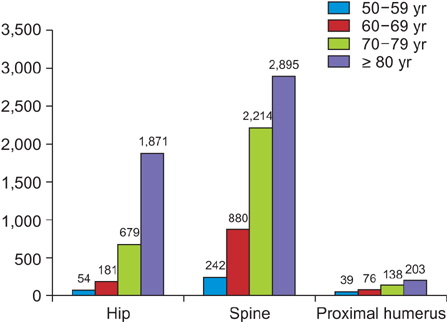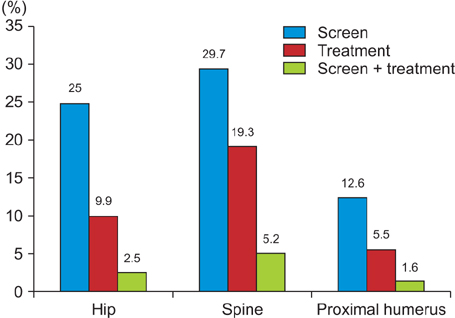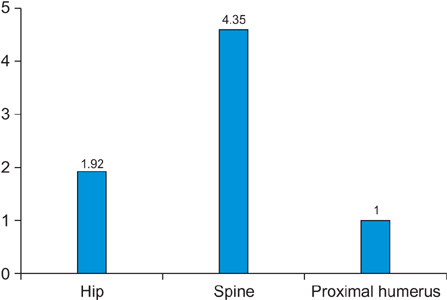Clin Orthop Surg.
2016 Sep;8(3):274-279. 10.4055/cios.2016.8.3.274.
The Adequacy of Diagnosis and Treatment for Osteoporosis in Patients with Proximal Humeral Fractures
- Affiliations
-
- 1Department of Orthopedic Surgery, Seoul National University Bundang Hospital, Seoul National University College of Medicine, Seongnam, Korea. ohjh1@snu.ac.kr
- 2Department of Orthopedic Surgery, Nanoori Hospital, Seoul, Korea.
- 3Department of Orthopedic Surgery, Seoul National University Hospital, Seoul National University College of Medicine, Seoul, Korea.
- KMID: 2374273
- DOI: http://doi.org/10.4055/cios.2016.8.3.274
Abstract
- BACKGROUND
The purpose of this study was to evaluate whether physicians' practice was adequate for the diagnosis and treatment of osteoporosis in patients with proximal humeral fracture over the age of 50 years, which is one of major osteoporotic fractures.
METHODS
A retrospective nation-wide cohort study was performed using data collected in 2010 by the Korean Health Insurance Review Agency. The incidences of fractures around the hip, spine, and proximal humerus in patients more than 50 years of age, the frequencies of diagnostic bone density scan for osteoporosis, and the prescription for the osteoporosis medication were analyzed and compared.
RESULTS
A search of database identified 48,351 hip fractures, 141,208 spine fractures, and 11,609 proximal humeral fractures in patients more than 50 years of age in 2010. Among these patients, 12,097 (25.0%) of hip fractures, 41,962 (29.7%) of spine fractures, and 1,458 (12.6%) of proximal humeral fractures underwent diagnostic bone density scan (p < 0.001); 4,773 (9.9%) of hip fractures, 27,261 (19.3%) of spine fractures, and 639 (5.5%) of proximal humeral fractures were managed with at least one medication approved for the treatment of osteoporosis (p < 0.001). Furthermore, 1,217 (2.5%) of hip fractures, 7,271 (5.2%) of spine fractures, and 188 (1.6%) of proximal humeral fractures received diagnostic bone density scans as well as osteoporosis medications (p < 0.001). Younger patients (50-69 years of age) were less likely to be evaluated and managed for osteoporosis relative to older patients (≥ 70 years of age) (p < 0.001); and men were less likely to be evaluated and managed for osteoporosis relative to women (p < 0.001).
CONCLUSIONS
Current physicians' practice pattern may be inadequate for the diagnosis and treatment of osteoporosis in patients of proximal humeral fractures over the age of 50 years. Additional study and educational programs are necessary to improve this care gap, beginning with physicians who are responsible for the fracture treatment and shoulder diseases.
Keyword
MeSH Terms
Figure
Cited by 3 articles
-
Factors Affecting Bone Mineral Density Measurement after Fracture in South Korea
Jin-Woo Kim, Yong-Chan Ha, Young-Kyun Lee
J Bone Metab. 2017;24(4):217-222. doi: 10.11005/jbm.2017.24.4.217.Trends in the Diagnosis of Osteoporosis in Patients with Distal Radius Fractures Based on a National Claims Database
Dae Geun Kim, Gi-Won Seo, Hye-Won Nam
J Bone Metab. 2019;26(4):247-252. doi: 10.11005/jbm.2019.26.4.247.Cortical Thickness Index of the Proximal Femur: A Radiographic Parameter for Preliminary Assessment of Bone Mineral Density and Osteoporosis Status in the Age 50 Years and Over Population
Bao NT Nguyen, Hironobu Hoshino, Daisuke Togawa, Yukihiro Matsuyama
Clin Orthop Surg. 2018;10(2):149-156. doi: 10.4055/cios.2018.10.2.149.
Reference
-
1. Johnell O, Kanis J. Epidemiology of osteoporotic fractures. Osteoporos Int. 2005; 16:Suppl 2. S3–S7.
Article2. Gass M, Dawson-Hughes B. Preventing osteoporosis-related fractures: an overview. Am J Med. 2006; 119:4 Suppl 1. S3–S11.
Article3. Kim SR, Park YG, Kang SY, Nam KW, Park YG, Ha YC. Undertreatment of osteoporosis following hip fractures in jeju cohort study. J Bone Metab. 2014; 21(4):263–268.
Article4. Holroyd C, Cooper C, Dennison E. Epidemiology of osteoporosis. Best Pract Res Clin Endocrinol Metab. 2008; 22(5):671–685.
Article5. Singh A, Adams AL, Burchette R, Dell RM, Funahashi TT, Navarro RA. The effect of osteoporosis management on proximal humeral fracture. J Shoulder Elbow Surg. 2015; 24(2):191–198.
Article6. Kannus P, Palvanen M, Niemi S, Parkkari J, Jarvinen M, Vuori I. Osteoporotic fractures of the proximal humerus in elderly Finnish persons: sharp increase in 1970-1998 and alarming projections for the new millennium. Acta Orthop Scand. 2000; 71(5):465–470.
Article7. Palvanen M, Kannus P, Niemi S, Parkkari J. Update in the epidemiology of proximal humeral fractures. Clin Orthop Relat Res. 2006; 442:87–92.
Article8. Klotzbuecher CM, Ross PD, Landsman PB, Abbott TA 3rd, Berger M. Patients with prior fractures have an increased risk of future fractures: a summary of the literature and statistical synthesis. J Bone Miner Res. 2000; 15(4):721–739.
Article9. Clinton J, Franta A, Polissar NL, et al. Proximal humeral fracture as a risk factor for subsequent hip fractures. J Bone Joint Surg Am. 2009; 91(3):503–511.
Article10. Aghamirsalim M, Mehrpour SR, Kamrani RS, Sorbi R. Effectiveness of educational intervention on undermanagement of osteoporosis in fragility fractures. Arch Orthop Trauma Surg. 2012; 132(10):1461–1465.
Article11. Dell R, Greene D, Schelkun SR, Williams K. Osteoporosis disease management: the role of the orthopaedic surgeon. J Bone Joint Surg Am. 2008; 90:Suppl 4. 188–194.
Article12. Harrington JT, Broy SB, Derosa AM, Licata AA, Shewmon DA. Hip fracture patients are not treated for osteoporosis: a call to action. Arthritis Rheum. 2002; 47(6):651–654.
Article13. Panneman MJ, Lips P, Sen SS, Herings RM. Undertreatment with anti-osteoporotic drugs after hospitalization for fracture. Osteoporos Int. 2004; 15(2):120–124.
Article14. Krappinger D, Bizzotto N, Riedmann S, Kammerlander C, Hengg C, Kralinger FS. Predicting failure after surgical fixation of proximal humerus fractures. Injury. 2011; 42(11):1283–1288.
Article15. Jung SW, Shim SB, Kim HM, Lee JH, Lim HS. Factors that influence reduction loss in proximal humerus fracture surgery. J Orthop Trauma. 2015; 29(6):276–282.
Article16. Carbone S, Papalia M. The amount of impaction and loss of reduction in osteoporotic proximal humeral fractures after surgical fixation. Osteoporos Int. 2016; 27(2):627–633.
Article17. Riggs BL, Khosla S, Melton LJ 3rd. Sex steroids and the construction and conservation of the adult skeleton. Endocr Rev. 2002; 23(3):279–302.
Article18. Willson T, Nelson SD, Newbold J, Nelson RE, LaFleur J. The clinical epidemiology of male osteoporosis: a review of the recent literature. Clin Epidemiol. 2015; 7:65–76.19. Cosman F, de Beur SJ, LeBoff MS, et al. Clinician's guide to prevention and treatment of osteoporosis. Osteoporos Int. 2014; 25(10):2359–2381.
Article20. Chehade M, Gill TK, Visvanathan R. Low energy trauma in older persons: where to next? Open Orthop J. 2015; 9:361–366.
Article21. Skedros JG, Holyoak JD, Pitts TC. Knowledge and opinions of orthopaedic surgeons concerning medical evaluation and treatment of patients with osteoporotic fracture. J Bone Joint Surg Am. 2006; 88(1):18–24.
Article22. Yoon BH, Baek JH, Lee YK, Ha YC, Koo KH. Knowledge on osteoporosis of prescriber according to level of medical institute. Yonsei Med J. 2014; 55(4):1058–1062.
Article23. Kim SR, Ha YC, Park YG, Lee SR, Koo KH. Orthopedic surgeon's awareness can improve osteoporosis treatment following hip fracture: a prospective cohort study. J Korean Med Sci. 2011; 26(11):1501–1507.
Article24. Farmer RP, Herbert B, Cuellar DO, et al. Osteoporosis and the orthopaedic surgeon: basic concepts for successful co-management of patients' bone health. Int Orthop. 2014; 38(8):1731–1738.
Article25. Sorbi R, Aghamirsalim M. Osteoporotic Fracture Program management: who should be in charge? A comparative survey of knowledge in orthopaedic surgeons and internists. Orthop Traumatol Surg Res. 2013; 99(6):723–730.
Article
- Full Text Links
- Actions
-
Cited
- CITED
-
- Close
- Share
- Similar articles
-
- Polarus Intramedullary Nail for Proximal Humeral and Humeral Shaft Fractures in Elderly Patients with Osteoporosis
- The Treatment of the Proximal Humeral Fracture using Bifurcate Blade Plate in Adult
- Medial and Lateral Dual Plate Fixation for Osteoporotic Proximal Humerus Comminuted Fracture: 2 Case Reports
- Conservative Treatment of Proximal Humeral Fracture
- Treatment with Modified Steinmann Pins and Tension Band Wiring Technique in Proximal Humeral Comminuted Fractures with Osteoporosis




